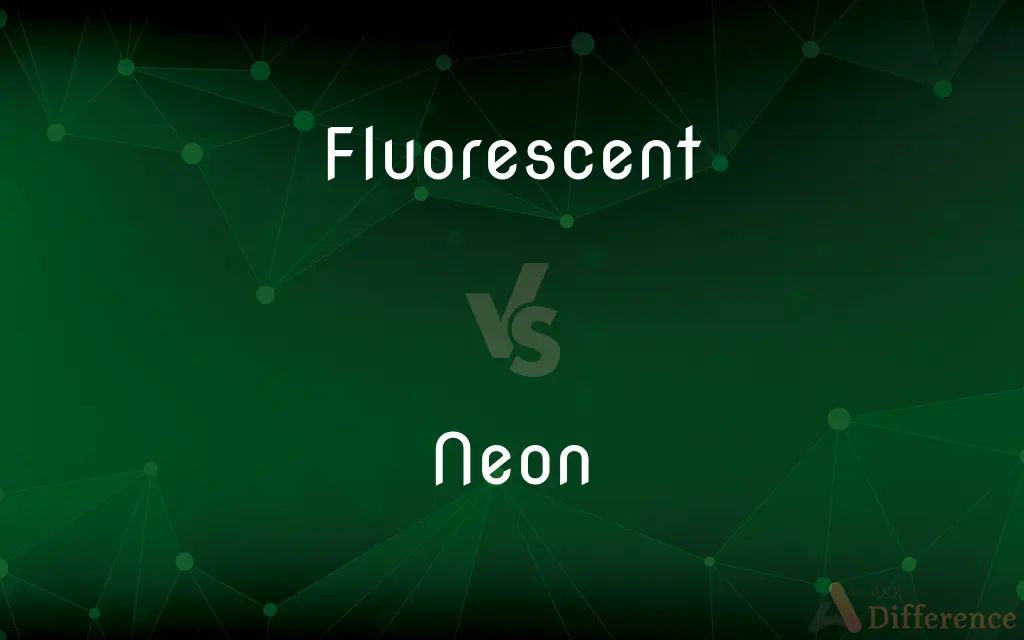Fluorescent vs. Neon — What's the Difference?
Edited by Tayyaba Rehman — By Maham Liaqat — Updated on April 27, 2024
Fluorescent lights use phosphor-coated tubes to emit light when electrified gas excites mercury vapor, whereas neon lights are glass tubes filled with neon gas that glows when electrified.

Difference Between Fluorescent and Neon
Table of Contents
ADVERTISEMENT
Key Differences
Fluorescent lighting technology involves a phosphor coating inside glass tubes that emit light when excited by ultraviolet light produced by electrified mercury vapor. On the other hand, neon lighting relies on the characteristic glow of electrified neon gas, contained within sealed glass tubes, which emits a bright reddish-orange light.
Fluorescent lights are commonly used for broad lighting applications such as in offices or schools due to their energy efficiency and long lifespan. Whereas, neon lights are favored for signage and decorative purposes because of their vibrant colors and ability to form intricate designs.
The energy efficiency of fluorescent lights is significantly higher, making them more suitable for areas requiring prolonged illumination. Neon lights, while less energy-efficient, provide a unique aesthetic that is irreplaceable in certain design contexts.
Fluorescent lights can emit a wide spectrum of colors by altering the phosphor blend inside the tube. In contrast, neon lights primarily emit a bright red-orange glow, but can display different colors by using different gases or colored glass.
The installation and maintenance of fluorescent lights are generally simpler and more cost-effective, supporting their use in commercial and residential settings. Neon lights require more specialized skills for installation and maintenance, reflecting their niche application in advertising and artistic installations.
ADVERTISEMENT
Comparison Chart
Light Mechanism
Electrified gas excites mercury vapor, emitting UV light that causes phosphor coating to glow.
Electrified neon gas glows directly.
Primary Use
General lighting (e.g., offices, homes)
Signage and decorative purposes.
Energy Efficiency
High
Lower than fluorescent
Color Variety
Broad, via different phosphors
Limited, requires different gases or coatings
Installation and Maintenance
Easier and cost-effective
Requires specialized skills and is typically more expensive
Compare with Definitions
Fluorescent
Known for energy efficiency, fluorescent lighting is favored in environments requiring long hours of use.
We replaced all bulbs with fluorescent ones to cut down on our energy bills.
Neon
Neon lighting is characterized by its vivid, glowing colors, commonly used in advertising signs.
The neon lights downtown make the streets vibrant at night.
Fluorescent
Fluorescent bulbs come in various shapes and sizes, including tubes and compact spirals.
The workshop used long fluorescent tubes to ensure ample light.
Neon
Despite being overshadowed by LEDs, neon lights remain popular for their distinct look.
Many artists prefer neon lights for their unique glow and color saturation.
Fluorescent
Disposal of fluorescent bulbs must be handled carefully due to the presence of mercury.
The broken fluorescent bulb was carefully cleaned up to avoid mercury contamination.
Neon
Neon lights are less energy-efficient but are irreplaceable for their aesthetic appeal in certain uses.
Neon lights are essential for the retro look of our vintage bar.
Fluorescent
The light emitted by fluorescent bulbs is generally cooler compared to incandescent bulbs.
The artist's studio used fluorescent lighting to avoid the heat of traditional bulbs.
Neon
The maintenance of neon lighting requires skilled craftsmanship, especially when repairing broken tubes.
The old neon sign required a skilled technician for its repair.
Fluorescent
Fluorescent light involves a phosphor-coated tube that glows when UV light is emitted inside it.
The office was brightly lit by rows of fluorescent tubes.
Neon
Traditional neon lights are crafted from bent glass tubes that are filled with gas and electrified.
The neon sign was custom-made for the diner.
Fluorescent
Of or relating to fluorescence.
Neon
Neon is a chemical element with the symbol Ne and atomic number 10. It is a noble gas.
Fluorescent
Exhibiting or produced by fluorescence
Fluorescent corals.
Fluorescent light.
Neon
Symbol Ne A rare, inert gaseous element occurring in the atmosphere to the extent of 18 parts per million and obtained by fractional distillation of liquid air. It is colorless but glows reddish orange in an electric discharge and is used in lasers, as a cryogen, and in cathode-ray tubes and other display devices. Atomic number 10; atomic weight 20.180; melting point -248.59°C; boiling point -246.08°C. See Periodic Table.
Fluorescent
Glowing as if with fluorescence; vivid
Bright fluorescent colors.
Neon
Electric signage made with neon lights.
Fluorescent
Of or relating to a light bulb that produces visible light by fluorescence, especially a glass tube whose inner wall is coated with a material that fluoresces when an electrical current causes a vapor within the tube to discharge photons.
Neon
An extremely bright shade of a color.
Fluorescent
A fluorescent light bulb.
Neon
A neon tetra.
Fluorescent
A lamp that is fitted with a fluorescent light bulb.
Neon
Of, relating to, or containing neon.
Fluorescent
Of or relating to fluorescence.
Neon
Of or relating to a form of lighting used especially on advertising signs and consisting of glass tubes filled with neon or other gases that emit colored light when subjected to an electric current.
Fluorescent
Exhibiting or produced by fluorescence.
The fluorescent plants shimmered in the darkness.
Neon
Extremely bright or vivid; fluorescent
Neon purple.
Fluorescent
Emitting visible light as a result of the excitation of phosphors by ultraviolet photons produced by the passage of an electrical current through an inert gas infused with mercury.
The quality of fluorescent lighting technology has improved dramatically in recent years.
Neon
(uncountable) The chemical element (symbol Ne) with an atomic number of 10. The second of the noble gases, it is a colourless, odorless inert gas.
Fluorescent
Glowing as if with fluorescence; vivid
Her shirt was fluorescent orange.
Neon
(countable) A form or sample of the element.
Fluorescent
A fluorescent light.
The fluorescents hummed day and night.
Neon
Neon signs or lights, collectively.
Fluorescent
Having the property of fluorescence.
Neon
(countable) A neon tetra fish.
Fluorescent
Emitting light during exposure to radiation from an external source
Neon
(of a color) That resembles a neon light; extremely bright; fluorescent
Fluorescent
Brilliantly colored and apparently giving off light;
Fluorescent colors
Neon
A colorless odorless gaseous element that give a red glow in a vacuum tube; one of the six inert gasses; occurs in the air in small amounts
Common Curiosities
Which type of lighting is more energy-efficient?
Fluorescent lighting is more energy-efficient compared to neon lighting.
Can fluorescent lights be used for outdoor lighting?
Yes, fluorescent lights are suitable for outdoor use, especially in fixtures designed for exposure to elements.
What are the typical applications of neon lighting?
Neon lighting is typically used for advertising signs, art installations, and architectural accents.
Can the color of fluorescent light be changed?
Yes, changing the phosphor blend in the coating can alter the color of the emitted light.
What is the primary difference in the lighting mechanism between fluorescent and neon lights?
Fluorescent lights use a phosphor coating illuminated by UV light, while neon lights glow due to electrified neon gas.
Are neon lights only available in red?
No, neon lights can emit different colors by using different gases or colored coatings.
What maintenance does neon lighting require?
Neon lighting requires periodic cleaning and may need repairs by specialists if the tubes are damaged.
Why are fluorescent lights more commonly used than neon lights?
Due to their energy efficiency and versatility, fluorescent lights are more commonly used across various applications.
Can fluorescent and neon lights be dimmed?
Special dimmable versions of fluorescent lights are available, while neon lights are inherently dimmable.
How long do neon lights last compared to fluorescent lights?
Neon lights can last for decades under proper maintenance, though they may not be as durable as fluorescent lights in continuous use environments.
Is it safe to handle broken fluorescent bulbs?
Handling broken fluorescent bulbs requires care due to the mercury content, which can be hazardous.
Do fluorescent and neon lights have the same impact on human health?
Fluorescent lights can sometimes cause eye strain or headaches due to flickering, whereas neon lights do not typically cause such issues.
How do environmental conditions affect fluorescent and neon lighting?
Fluorescent lights may not perform well in cold temperatures, whereas neon lights are generally unaffected by outdoor conditions.
Are there environmentally friendly alternatives to these lights?
LED lights serve as environmentally friendly alternatives to both fluorescent and neon lights, offering better energy efficiency and less environmental impact.
What safety precautions should be taken when installing neon lighting?
Proper insulation and handling are crucial to avoid electric shocks and ensure safe installation of neon lighting.
Share Your Discovery

Previous Comparison
Outright vs. Downright
Next Comparison
Colander vs. SieveAuthor Spotlight
Written by
Maham LiaqatEdited by
Tayyaba RehmanTayyaba Rehman is a distinguished writer, currently serving as a primary contributor to askdifference.com. As a researcher in semantics and etymology, Tayyaba's passion for the complexity of languages and their distinctions has found a perfect home on the platform. Tayyaba delves into the intricacies of language, distinguishing between commonly confused words and phrases, thereby providing clarity for readers worldwide.
















































